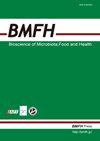芝麻木脂素上调谷胱甘肽s -转移酶表达,下调microRNA-669c-3p
IF 2.9
4区 医学
Q2 Agricultural and Biological Sciences
引用次数: 1
摘要
氧化应激与衰老和心血管疾病、阿尔茨海默病和癌症等疾病有关。谷胱甘肽s -转移酶(GST)是一类解毒酶,在对抗氧化应激中起着至关重要的作用。因此,有必要开发生理功能食品和农产品,以提高商品及服务税的活性。芝麻素和芝麻素是精制芝麻油中的主要木脂素,具有抗氧化应激作用等有益特性。先前的一项研究表明,芝麻素上调了GST活性。本研究旨在阐明芝麻木脂素增强GST活性的机制。C57BL/6J小鼠口服20 mg/kg体重的芝麻木脂素(芝麻素:皂苷素=1:1),连续7 d。口服芝麻木脂素增加小鼠肝脏GST活性。此外,木脂素上调GSTA1、GSTA4和GSTM4蛋白的表达。微阵列分析显示,芝麻木脂素改变了各种microRNAs (miRNAs)的表达(84个上调,19个下调)。我们还发现,在19个mirna中,包括miR-669c-3p在内的16个mirna可能负调控GST的表达,这些mirna的表达因芝麻木脂素而降低。据报道,miR-669c与GST呈负相关。此外,我们用miR-669c-3p模拟物转染了NMuLi细胞,并评估了miR-669c-3p对GST mRNA和蛋白表达的影响。结果表明,miR-669c-3p模拟物抑制GSTA4和GSTM4的mRNA和蛋白水平。综上所述,芝麻木脂素增加了GST蛋白的表达和活性,下调了mirna,包括miR-669c-3p,这可能是GST的抑制因子。本文章由计算机程序翻译,如有差异,请以英文原文为准。
Sesame lignans upregulate glutathione S-transferase expression and downregulate microRNA-669c-3p
Oxidative stress is associated with aging and pathologies such as cardiovascular diseases, Alzheimer’s disease, and cancer. Glutathione S-transferase (GST), a family of detoxification enzymes, plays a crucial role in countering oxidative stress. Therefore, there is a need for the development of physiologically functional foods and agricultural products, which enhance GST activity. Sesamin and episesamin are major lignans in refined sesame oil that exhibit beneficial properties including antioxidative stress effects. A previous study showed that sesamin upregulated GST activity. This study aimed to elucidate the mechanism underlying the GST activity enhancement elicited by sesame lignans. C57BL/6J mice were orally administered 20 mg/kg body weight sesame lignans (sesamin:episesamin=1:1) for 7 days. Oral administration of sesame lignans increased the GST activity in the mouse liver. Furthermore, the lignans upregulated GSTA1, GSTA4, and GSTM4 protein expression. Microarray analysis revealed that sesame lignans changed the expression of various microRNAs (miRNAs) (84 upregulated, 19 downregulated). We also found 16 miRNAs, including miR-669c-3p, that may negatively regulate GST expression among the 19 miRNAs with reduced expression caused by the sesame lignans. miR-669c is reportedly negatively correlated with GST. Additionally, we transfected NMuLi cells with an miR-669c-3p mimic and evaluated the effect of miR-669c-3p on GST mRNA and protein expressions. The results showed that the miR-669c-3p mimic suppressed the mRNA and protein levels of GSTA4 and GSTM4. In conclusion, sesame lignans increased GST protein expression and activity and downregulated miRNAs, including miR-669c-3p, which is a possible suppressor of GST.
求助全文
通过发布文献求助,成功后即可免费获取论文全文。
去求助
来源期刊

Bioscience of Microbiota, Food and Health
Immunology and Microbiology-Applied Microbiology and Biotechnology
CiteScore
5.50
自引率
3.20%
发文量
24
期刊介绍:
Bioscience of Microbiota, Food and Health (BMFH) is a peer-reviewed scientific journal with a specific area of focus: intestinal microbiota of human and animals, lactic acid bacteria (LAB) and food immunology and food function. BMFH contains Full papers, Notes, Reviews and Letters to the editor in all areas dealing with intestinal microbiota, LAB and food immunology and food function. BMFH takes a multidisciplinary approach and focuses on a broad spectrum of issues.
 求助内容:
求助内容: 应助结果提醒方式:
应助结果提醒方式:


